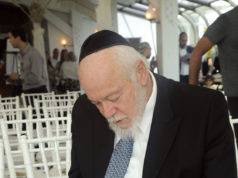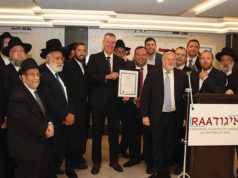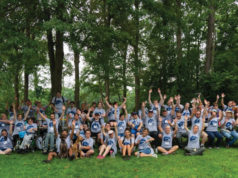
I’ve always been curious about my heritage. Growing up in Brooklyn, I always knew that the Sephardic community was made up of Jews who were exiled from Spain and who moved to countries like Egypt, Morocco, Syria and Lebanon. But, until about a year ago I knew virtually nothing about life in Beirut, Lebanon, except that it is where my family originated. My whole perspective about life and what I thought was an arcane society drastically changed when I took an hour to speak with my revered jido (grandfather), Jacques Srour. In fact, I now envy the Beirut life.
My jido smiled when he saw I was interested in his pastimes. He said, “Life in Beirut was nothing like life here in America. It was a more relaxed Mediterranean lifestyle where people did the things that they enjoyed. Earning a living was not difficult and the weather was gorgeous, with mild winters and long summers.”

Indeed, Beirut before the civil war of 1975 was a prosperous cosmopolitan city with a beautiful coastline. It was known as the “Paris of the Middle East,” because of its beauty and dominance as a tourist destination. While the joie de vivre is evident, Lebanon has something that France does not—it has the Lebanese people, who are warm, wonderful, considerate, open to new ideas, intelligent and generous.
The Jewish community in Lebanon dates back to 1000 BC. Jewish physicians, soldiers, civil servants, craftsmen and bankers were once fully integrated into Lebanese society. According to the Bible, King Solomon and Hiram (the king of Tyre) shared the same language. In 132 AD, following the Bar Kochba revolt, several Jewish communities moved to what is known as Lebanon today. In 922, a community was set up in Sidon. It was not until 1071, when Lebanon was under the reign of Emir Bashir II that the community flourished in Tyre. It had its own synagogue and cemetery. However, the past could not compare to what the community would look like in the 20th century.

Around 1911, Jews from Syria, Iraq, Turkey, Greece and Persia had settled in Beirut, expanding the community to almost 5,000. The French mandate of Syria (which included Lebanon) began after WWI and marked a new age of prosperity for Jews. The Jews settled in the Wadi Abu Jamil district, which would become the cultural, religious, social and economic center of the community. Lebanese Jews took to the mountains in the summer for vacation and consequently built synagogues in Aley and Bahmdoun.
In 1926, when a new constitution came into force, the Jews of Lebanon were the only Middle-Eastern community to be constitutionally protected. Lebanese Jews loved their country and felt a special sort of freedom to practice as they wished. In fact, two Jewish newspapers were created during this time period: Al-Alam al Israili (the Israelite World) and Le Commerce du Levant, an economic periodical.

However, more importantly, the main synagogue in central Beirut was constructed in 1925. It was named Magen Abraham thanks to the contribution of the Sasson family from Iraq. In addition, the land for the shul was donated by Yitzchak Mann. The head of the Jewish community, Josef Farhi, helped in completing the interior. The synagogue was used for Torah lectures, weddings, bar mitzvahs and other festive events. Magen Abraham was just one of 14 synagogues in Beirut. The chief rabbis of Beirut include Yaakov Attiyeh, who moved to Bat Yam in 1968 and Chahoud Chreim A”H, who moved to Brazil in 1976.
The Jews lived a very prosperous life in Beirut for decades. A Jewish-French school my parents attended was called the Alliance, where the standard education included the study of French, Arabic, Hebrew and English. Another school was a yeshivah near Magen Abraham in the Wadi district called Talmud Torah. Despite the 1948 Arab-Israeli war, Beirut was the only city that saw its Jewish population increase; it did so to almost 9,000 by 1951. Two Jewish banks opened their doors: the Safra Bank and the Zilkha Bank. The liberal atmosphere allowed the community to grow to 14,000 before the civil war of 1958.
There is a well-known lady who lived in Wadi Abu Jamil worth mentioning—Shula Cohen Kishik. In a story reminiscent of Queen Esther in the Bible, she risked her comfortable lifestyle and social life to help her people, but unlike Esther, Shula payed a high price for her choice. Shula helped thousands of Jews from Sham and Aleppo come through Lebanon to Israel. She found escape routes for them by land, sea and air. She secretly provided food and shelter to these people, but more importantly opened the window to a better life. Unfortunately, after 14 years of smuggling Jews into Israel through Lebanon she was caught and sent to prison. Today, Shula is alive and resides quietly in Jerusalem. Shula Cohen deserves our hakarat hatov (recognizing the good).
During the civil war of 1958, many Jews were convinced that the situation in Lebanon was deteriorating. Many left for Europe, while others immigrated to the Americas. However, most left after the 1967 June Arab-Israeli War, when religious divisions became evident. Of the once strong community of 14,000, only 3,600 remained. Even they would soon leave because of a second civil war in 1975. It blew away all hopes of returning to their former lives in Beirut. Schools and synagogues in Wadi Abu Jamil closed and Lebanese Jews felt their security compromised.
Today, all that remains of a 3,000-year presence in Lebanon are relics of a former glorious life including the stunning structure of Magen Abraham and a cemetery. All my jido can tell me is that Jews cannot live in a country without security and political stability. Although both my grandfathers, Jacques Srour and Judah Moadeb, built their lives in Beirut they were forced to leave. The Srour family ended up in Brooklyn, New York and the Moadeb family in São Paulo, Brazil. However, all Lebanese expatriate communities around the globe including those in Paris, New York, Montreal and São Paulo, can and will recount the happy days in Wadi Abu Jamil.
_______________
Jack Srour is a freelance writer for publications relating to history, politics and Judiasm. He is currently a Provost Scholars’ Honors Student at Baruch College majoring in finance and investments. His articles appear in Baruch’s Hillel publication—Hakesher Magazine.



